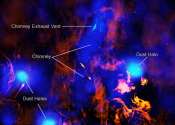Suzaku catches retreat of a black hole's disk
(PhysOrg.com) -- Studies of one of the galaxy's most active black-hole binaries reveal a dramatic change that will help scientists better understand how these systems expel fast-moving particle jets.

(PhysOrg.com) -- Studies of one of the galaxy's most active black-hole binaries reveal a dramatic change that will help scientists better understand how these systems expel fast-moving particle jets.
Astronomy
Dec 10, 2009
2
0

It is believed that the formation and growth of most galaxies across the history of the universe has been fueled by supermassive black holes growing together with their host galaxy as they collect matter to attain millions ...
Astronomy
May 13, 2019
17
540

(PhysOrg.com) -- Studies of two supernova remnants using the Japan-U.S. Suzaku observatory have revealed never-before-seen embers of the high-temperature fireballs that immediately followed the explosions. Even after thousands ...
Astronomy
Dec 30, 2009
4
0

Using NASA's Neil Gehrels Swift Observatory, astronomers have identified two new outbursts from the magnetar 1E 1048.1−5937. The newly detected events could shed more light on the nature of this source. The finding is detailed ...

(PhysOrg.com) -- Two spectacular tails of X-ray emission has been seen trailing behind a galaxy using the Chandra X-ray Observatory.
Astronomy
Jan 22, 2010
1
3

Using NASA's Chandra X-ray Observatory, astronomers have located an exhaust vent attached to a "chimney" of hot gas blowing away from the center of the Milky Way galaxy. Their paper describing these results is published in ...
Astronomy
May 10, 2024
1
124

Using NASA's Chandra spacecraft, astronomers have inspected X-ray emission from the center of a young radio galaxy known as NGC 3894. Results of this study, presented in a paper published June 24 on the arXiv pre-print server, ...

A new material that can selectively capture carbon dioxide (CO2) molecules and efficiently convert them into useful organic materials has been developed by researchers at Kyoto University, along with colleagues at the University ...
Materials Science
Oct 11, 2019
0
108

(PhysOrg.com) -- New results from NASA's Chandra X-ray Observatory and the Magellan telescopes suggest that a dense stellar remnant has been ripped apart by a black hole a thousand times as massive as the Sun. If confirmed, ...
Astronomy
Jan 4, 2010
9
0

(PhysOrg.com) -- The star TW Hydrae is located about 150 light-years from earth in the direction of the constellation of Hydrae, the Water Snake. This star is relatively young -- at about 10 million years old it has passed ...
Astronomy
Feb 5, 2010
0
0